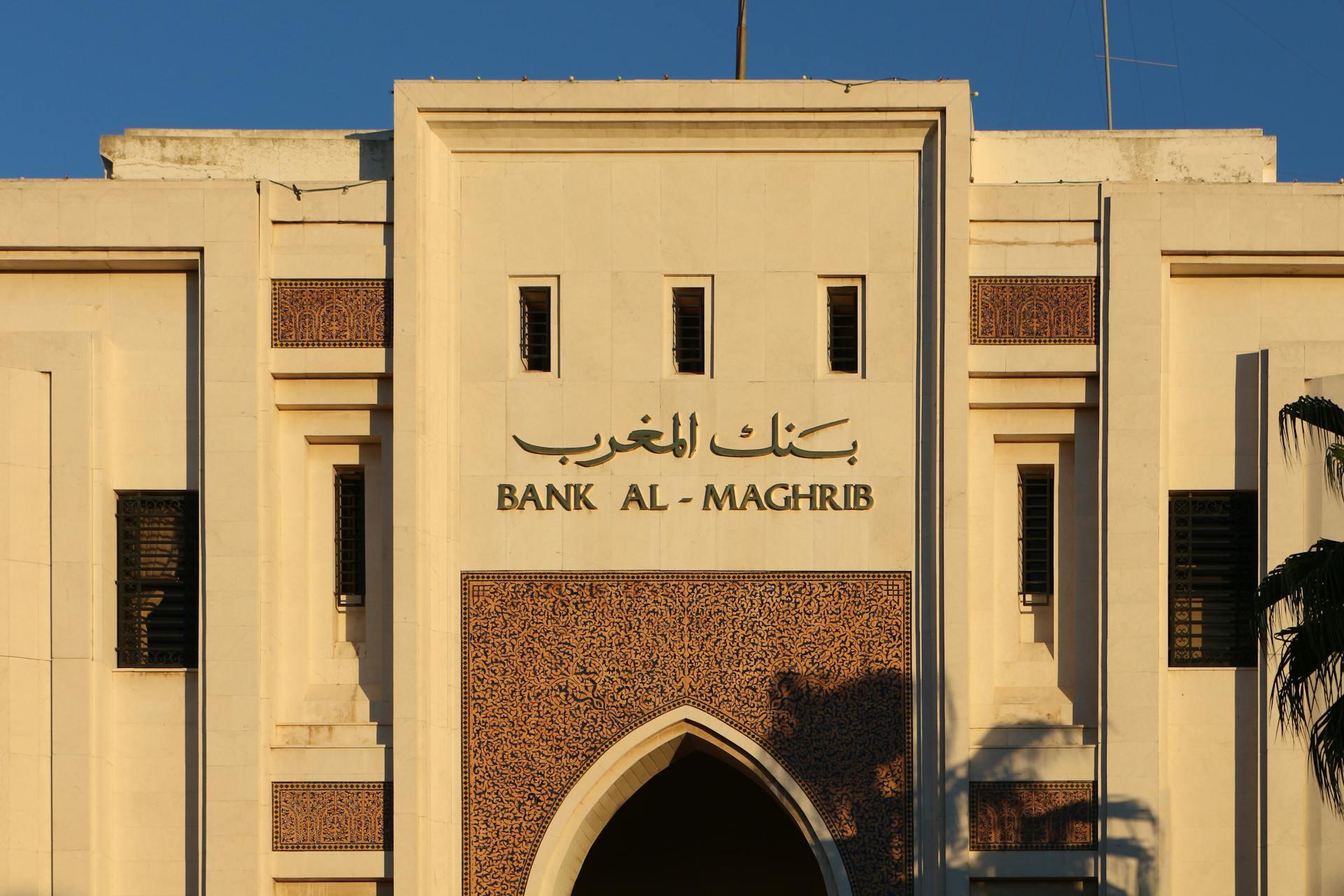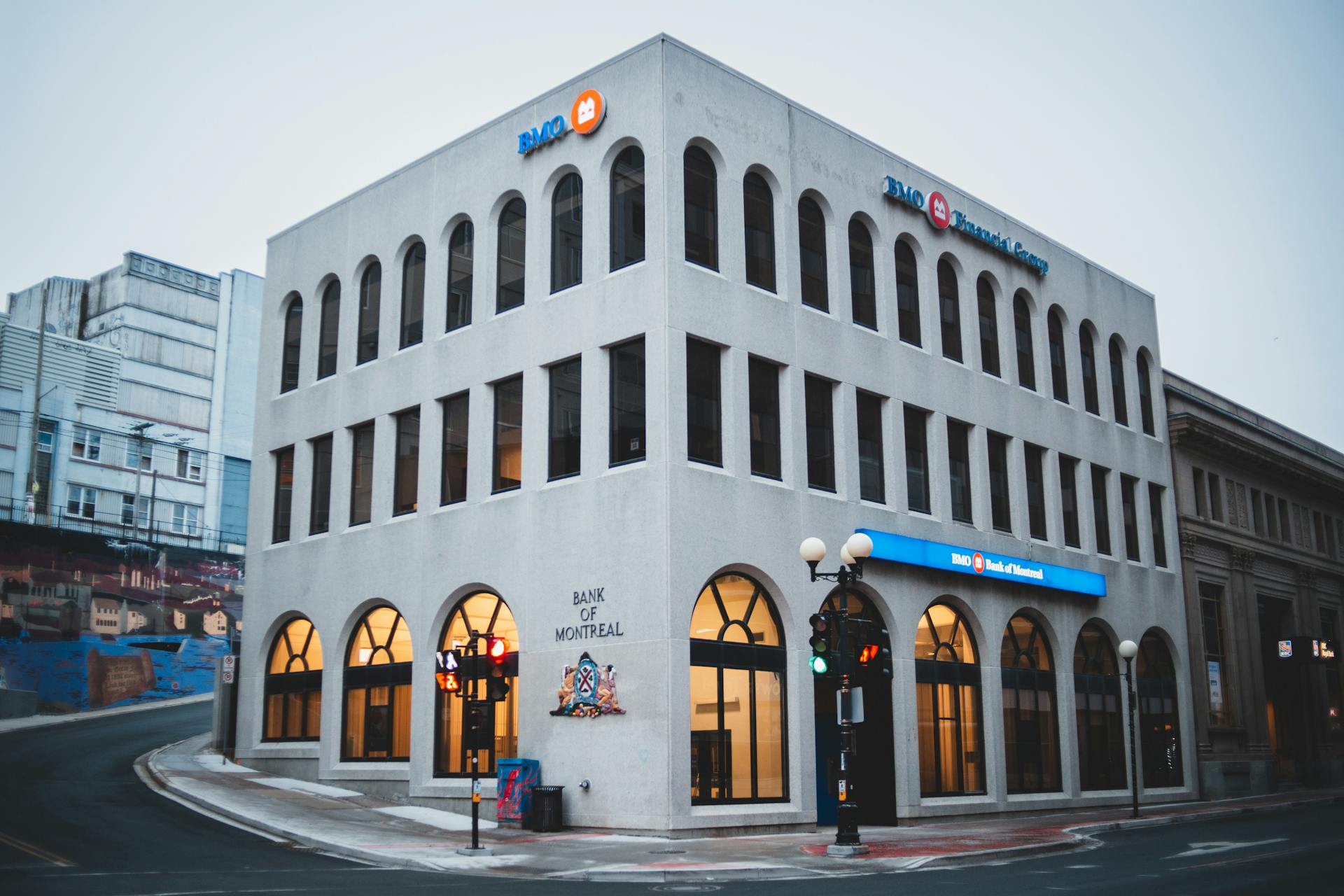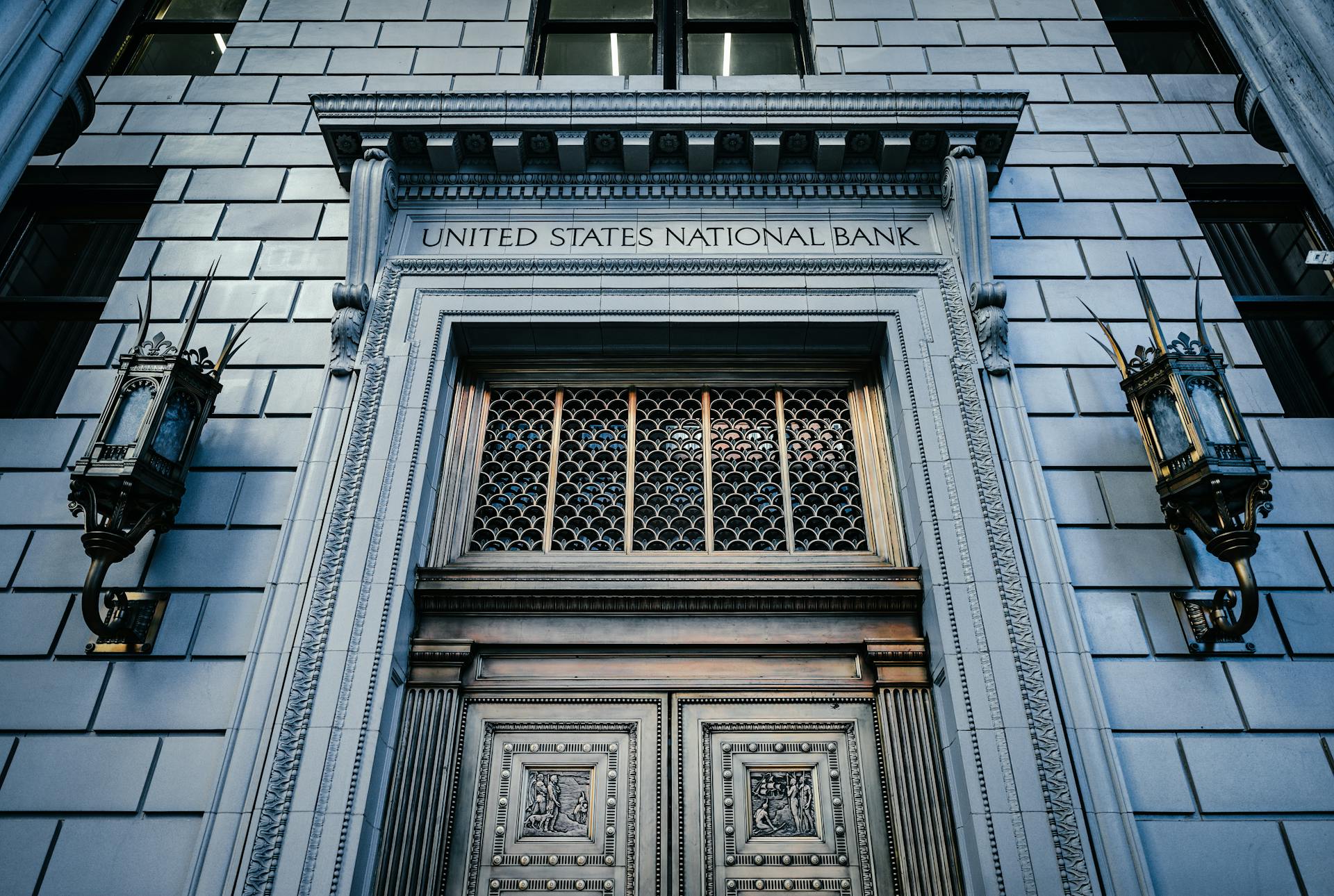
The Bank of England has a rich and fascinating history that spans over 300 years. Established in 1694, it was initially created to raise funds for the government to fight wars.
The bank's early years were marked by controversy, with many questioning its legitimacy and purpose. It wasn't until 1708 that the bank was officially recognized as a central bank.
In 1844, the bank's charter was renewed, and it was granted a monopoly on the issue of banknotes. This move helped to stabilize the currency and establish the bank as a trusted institution.
The bank's headquarters has been located on Threadneedle Street in London since 1734, a location that has become synonymous with British finance.
History of Bank of England
The Bank of England has a rich history dating back to 1694, when it was first founded. It's amazing to think about all the changes it has undergone over the centuries.
One significant change occurred in 1715, when the bank took on the responsibility of managing Government Stocks, which formed the bulk of the national debt. This was a major task, involving issuing stocks to stockholders, paying dividends, and maintaining a register of transfers.

In 1998, the bank's operational independence was granted, leading to a significant shift in its responsibilities. The Debt Management Office was established to take over government debt management, and by 2000, it also began issuing Treasury bills. This marked a major change in the bank's role.
The bank had provided retail banking services to the government since its foundation, but in 2008, it decided to withdraw from this service. Today, these services are provided by a range of other financial institutions and managed by the Government Banking Service.
Worth a look: PNC Financial Services
18th Century
In 1700, the Hollow Sword Blade Company was purchased by a group of businessmen who attempted to establish a competing English bank, but their goal was ultimately unsuccessful.
The Bank of England's initial monopoly on English banking was set to expire in 1710, but it was instead renewed. This renewal had a significant impact on the bank's operations.
The idea of the national debt emerged around this time, and the bank played a key role in managing it. The 1715 Ways and Means Act authorized the bank to receive subscriptions for government-issued 5% annuities, which raised £910,000.

By the 1742 Act, the bank became the only joint-stock company allowed to issue bank notes in the metropolis. This marked a significant milestone in the bank's history.
The bank's charter was renewed in 1742 and again in 1764. The bank's staff grew to 96 members by 1734.
The South Sea Company and the East India Company also became major lenders to the government during this time.
19th Century
The 19th century was a transformative time for the Bank of England. In 1844, the Bank Charter Act was passed, which allowed the bank to issue more banknotes and expanded its role in the British economy.
The bank's note issue was increased from £14 million to £14.5 million, giving it more flexibility to manage the money supply. This change helped stabilize the economy and reduce the risk of inflation.
The bank's gold reserves were also increased, reaching £100 million by 1890. This accumulation of gold reserves helped maintain the bank's creditworthiness and stability.
The bank's role in the British economy continued to grow, with its notes becoming a widely accepted form of payment. By the end of the century, the Bank of England had become a cornerstone of the British financial system.
On a similar theme: Will Banks Buy Gold
Incorporation

The royal charter of the Bank of England was granted on 27 July 1694, just three months after the passing of the Act.
The £1.2 million was raised in a remarkably short 12 days, with 1,268 people subscribing to the Bank Stock.
Most of the original subscribers were from the 'mercantile middle classes of London', with many tradesmen and artisans also contributing.
A quarter of the total amount raised came from 'esquires', while 21% came from merchants and 15% from titled aristocrats.
Twelve percent of the original subscribers were women, which was a notable proportion at the time.
King William and Queen Mary jointly invested the maximum permitted sum of £10,000, as did a handful of others, including Sir John Houblon.
Additional reading: SpareBank 1 SMN
Bank Operations
The Bank of England's bank operations are a vital part of its role in maintaining the UK's financial stability. The bank's operations are overseen by the Prudential Regulation Authority (PRA), which ensures that banks operate safely and soundly.

Banks in the UK are required to hold a minimum level of capital and liquidity to cover potential losses and maintain access to funding. This is to prevent banks from taking on excessive risk and to protect depositors' funds.
The Bank of England also provides banking services to the government, including managing the government's cash and securities.
21st Century
The 21st century has brought significant changes to the Bank of England's operations.
In 2002, the bank decided to sell its banknote-printing operations to De La Rue, under the advice of Close Brothers Corporate Finance Ltd.
The bank's mandate expanded in 2011 with the creation of an interim Financial Policy Committee (FPC) to spearhead the bank's new focus on financial stability.
The Financial Services Act 2012 gave the bank additional powers and bodies, including an independent FPC, the Prudential Regulation Authority (PRA), and the Financial Conduct Authority.
Canadian Mark Carney became the Governor of the Bank of England in 2013, serving an initial five-year term before his term was extended to 2019 and then again to 2020.
As of January 2014, the bank had four Deputy Governors, a significant increase in leadership.
Andrew Bailey succeeded Carney as Governor on 16 March 2020, bringing new leadership to the bank.
Here's an interesting read: Maldives Monetary Authority
Monetary Stability

Monetary stability is crucial for any bank operation. It's the foundation upon which all other banking activities are built.
Stable prices are a key component of monetary stability. Prices that remain steady over time allow banks to accurately forecast their expenses and revenues.
Secure forms of payment are also vital for monetary stability. This ensures that customers can trust their money is safe and can be accessed when needed.
Banks must maintain a balance between offering convenient payment options and preventing financial instability.
Worth a look: Problems with Td Bank Banking Payment System Complaints
List of Branches
The Bank of England has a rich history, and its branch operations are a fascinating aspect of its operations. The bank's first branches opened in 1826 in Birmingham, Gloucester, and Manchester, with Birmingham being the first to open in 1827.
Some of the bank's earliest branches were short-lived, such as the Exeter branch which closed just seven years after opening due to trading losses. The business was transferred to Plymouth, which was a more successful location.
If this caught your attention, see: Branch (banking)

A notable fact about the bank's branch operations is that some branches were located in historic buildings. For example, the Birmingham branch was initially located in the former banking house of Gibbins, Smith & Goode on Union Street.
Here's a list of some of the Bank of England's earliest branches:
It's worth noting that some branches were relocated to new buildings over the years. For example, the Birmingham branch moved to a new building on Bennetts Hill in 1838, and then to the former Staffordshire Joint Stock Bank premises at 1 Temple Row in 1890.
Asset Purchase Facility
The Asset Purchase Facility (APF) has been a crucial tool for the Bank of England since January 2009, buying high-quality assets to improve liquidity in the credit markets.
It's also the mechanism by which the bank's policy of quantitative easing (QE) is achieved, under the auspices of the Monetary Policy Committee (MPC). The APF continues to operate its corporate facilities, managed by a subsidiary company of the Bank of England, the Bank of England Asset Purchase Facility Fund Limited (BEAPFF).

The APF has managed massive funds, peaking at £895 billion in 2020, comprising £875 billion of UK government bonds and £20 billion of high-grade commercial bonds.
As of 2021, the outstanding stock of UK government bonds was £875 billion, and £20 billion of high-grade commercial bonds.
The Bank of England announced its intention to wind down the QE portfolio in February 2022, initially by not replacing maturing bonds.
Concept
The concept of a national bank was first proposed by William Paterson in 1691, who envisioned a public fund that would facilitate receipts and payments in and around London and Westminster.
This idea laid the groundwork for the bank's first Charter and the legislation that made its establishment possible. Charles Montagu, a Member of Parliament, played a crucial role in steering the proposals through Parliament, which later led to his appointment as Chancellor of the Exchequer.
Michael Godfrey helped persuade City financiers of the bank's benefits, and he was subsequently chosen to be the bank's first Deputy Governor.
The Brokers' Exchange

The Brokers' Exchange in the Bank was a hub of activity in the late 18th and early 19th century.
It was located in the Rotunda of the Bank of England, where stock-brokers, stock-jobbers, and other persons would meet to transact business in public funds.
The Rotunda was a central location for trading, with offices branching off from it where books listing every individual's registered interest in the fund were kept.
Trading in the Rotunda ceased in 1838, but the space continued to be used for the cashing of fundholders' dividend warrants.
The use of the Rotunda for trading was a precursor to the establishment of the London Stock Exchange, which eventually took over the role of facilitating public fund transactions.
Take a look at this: London Stock Exchange
Governance and Structure
The Bank of England's governance and structure were established from the very beginning. The first Governor was John Houblon, and the first Deputy Governor was Michael Godfrey.
The bank's governance was vested in the Governor, Deputy Governor, and a Court of 24 Directors, who were elected annually by the bank's registered stockholders. These Directors were mostly merchant bankers recruited from the City.

The Court appointed three senior officers: the Secretary and Solicitor, the First Accomptant, and the First Cashier. They were responsible for the day-to-day running of the bank alongside the Governor and Deputy Governor.
These officers went on to head up the main divisions of the bank's operations for the next 250 years. The Chief Cashier oversaw the 'cash side', the Chief Accountant oversaw the 'stock side', and the Secretary oversaw internal administration.
Post-War Nationalisation
In the aftermath of World War II, many countries turned to nationalisation as a way to restructure their economies.
The British government nationalised key industries such as coal, steel, and railways, which had been largely controlled by private companies before the war.
Risk Management
Risk Management is a critical aspect of the bank's governance and structure. The bank's Financial Policy Committee (FPC) was set up to identify and monitor risks in the financial system.
The FPC takes a proactive approach to risk management by publishing its findings in a biannual Financial Stability Report. This report provides valuable insights into the bank's risk management efforts and helps stakeholders stay informed.
The FPC's macroprudential regulation approach involves taking appropriate action where necessary to mitigate potential risks. This demonstrates the bank's commitment to responsible risk management practices.
Governance

The Governor of the bank was John Houblon, and the first Deputy Governor was Michael Godfrey. They were instrumental in setting the tone for the bank's governance.
The bank's governance was vested in the Governor, Deputy Governor, and a Court of 24 Directors, who were mostly merchant bankers recruited from the City. These Directors were elected annually by a General Court of all the Bank's registered stockholders, known as the Proprietors.
The common seal of the Court of Directors, adopted on 30 July 1694, depicted Britannia sitting and looking on a Bank of mony, which has been the bank's emblem ever since.
Court of Directors
The Court of Directors is a unitary board responsible for setting the Bank of England's strategy and budget, as well as making key decisions on resourcing and appointments.
The board consists of five executive members from the bank, including the Governor and four Deputy Governors, each overseeing a different area of the bank's work. These executive members serve for a period of eight years, with the Governor serving the longest term.
On a similar theme: Banks Board Bureau

In addition to the executive members, the Court of Directors also includes up to nine non-executive members, who are appointed by the Crown. These non-executive members serve for up to four years and include experts from various fields.
The Chancellor selects the Chairman of the Court from among the non-executive members, who plays a key role in guiding the board's discussions and decisions.
The Court of Directors is required to meet at least seven times a year to discuss and decide on important matters related to the bank's operations.
Here is a list of the current members of the Court of Directors, as of 2024:
Governors
The Governor of the Bank of England plays a crucial role in the bank's governance, serving for a period of eight years. John Houblon was the first Governor of the bank, appointed in 1694.
The Governor is assisted by a Deputy Governor, who oversees a different area of the bank's work. In 1694, Michael Godfrey was the first Deputy Governor.

The Court of Directors is a unitary board responsible for setting the bank's strategy and budget. It consists of five executive members, including the Governor and four Deputy Governors, and up to 9 non-executive members.
The Court of Directors meets at least seven times a year, with the Governor serving for eight years and the Deputy Governors serving for five years. Non-executive members serve for up to four years.
Here is a list of some of the Governors of the Bank of England since the 20th century:
Restructuring and Rebuilding
The Bank of England underwent significant restructuring during the governorship of Montagu Norman, from 1920 to 1944, as it moved away from commercial banking and towards becoming a central bank.
Economists and statisticians were increasingly employed at the bank to help with the transition. The 'Peacock Committee' was set up to advise on organisational improvements and recommended the appointment of paid executive Directors alongside traditional non-executive members of the Court.

The bank's work had increased significantly since the end of the First World War, leading to a decision to expand its headquarters on Threadneedle Street. Between 1925 and 1939, the bank's headquarters were comprehensively rebuilt by Herbert Baker.
Herbert Baker's steel-framed building stands seven storeys high, with three vault storeys extending below ground level. The building is decorated with sculpture and bronze work by Charles Wheeler, plasterwork by Joseph Armitage, and mosaics by Boris Anrep.
The bank's operations and staff were relocated to Hampshire for the duration of the war, including the printing works and various other offices. Those who remained at Threadneedle Street, including the Directors, moved their offices into the underground vaults.
The UK government left the European Exchange Rate Mechanism in September 1992, resulting in a loss of over £3 billion for HM Treasury. This led to closer communication between the government and the bank.
You might enjoy: Irish Nationwide Building Society
The Picquet
The Picquet was a nightly guard provided by soldiers of the Household Brigade to protect the bank and the Mansion House. This practice started in June 1780 after the Lord Mayor of London petitioned the Secretary of State for military protection.

The guard was known as the 'Bank Picquet' and was stationed on the site of the church that had been demolished due to the 1780 Gordon Riots. The riots had caused significant damage to the area.
The guard was housed in a barracks built by Taylor in the north-west corner of the site, which had a separate entrance on Princes Street. This barracks was a temporary solution to provide a safe location for the soldiers to rest.
The Bank Picquet continued to be stationed on the site until 1973, marking a significant period of time where the bank and surrounding area were under military protection.
Check this out: First Republic Bank San Francisco Bay Area
Services and Facilities
The Bank of England offers a range of services and facilities to support its customers and the wider economy.
The Bank's services include acting as the UK's central bank, maintaining financial stability, and setting monetary policy.
The Bank of England has a long history of providing banking services to the government and other financial institutions.
Worth a look: Banks ATM Network and Customer Services
One of the key facilities provided by the Bank is its gold reserves, which are held in vaults beneath the Bank's headquarters in London.
The Bank also provides secure storage for other valuable items, including historical documents and works of art.
The Bank's Museum, located on its Threadneedle Street site, is a popular tourist destination and offers a fascinating glimpse into the Bank's history and operations.
Legislation and Regulation
The Bank of England plays a crucial role in shaping the UK's financial landscape, and it's governed by a robust set of laws and regulations.
The Bank of England is a public corporation, established in 1694, and is accountable to the UK Parliament, which has the power to scrutinize its activities and make changes to its operations.
The Bank's independence is maintained through its operational autonomy, which allows it to make decisions without interference from the government, but it's also subject to parliamentary oversight and accountability.
Resolution

The UK's Resolution Authority is a critical component of the country's financial system. The Bank of England serves as the Resolution Authority for any bank or building society deemed "too big to fail", as per the Banking Act 2009.
This role empowers the bank to take swift action in the event of a bank failure, with the primary objective of protecting the UK's vital financial services and maintaining financial stability. The bank's authority in this matter was established in response to the 2007-2008 financial crisis.
The bank's ability to resolve financial crises has been reinforced by the safeguards put in place after the 2007-2008 financial crisis, which were designed to protect savers, investors, and borrowers from threats to the financial system.
Recommended read: In a Fractional Reserve Banking System Banks Create Money Because
Legislation
The Tonnage Act 1694 played a crucial role in the establishment of the Bank of England. This Act granted the Government the right to levy certain duties on shipping and tonnage to secure the loan.
Check this out: Banking Act 1979

The Act was approved by Parliament to provide a fund for the subscribers, who would receive interest on their investments. The subscribers were to be incorporated under the name of the Governor and Company of the Bank of England.
The terms of the loan were set at 8% per annum, with a service charge of £4,000 per annum payable to the bank for management. This was a significant rate, considering the dire state of public finances at the time.
The Act limited the subscribers' investment to a maximum of £10,000 each in the first instance, with a total limit of £1,200,000. The Exchequer was expected to raise the remaining £300,000 through other forms of borrowing.
The Bank of England celebrated its three-hundredth birthday in 1994, marking a significant milestone in its history.
Events and Crises
The Bank of England has faced its fair share of crises and conflicts over the years. The credit crisis of 1772 is often described as the first modern banking crisis faced by the Bank of England.
Business was booming during the American War of Independence, with George Washington remaining a shareholder throughout the period. This was a notable exception to the usual economic downturns that often accompanied wars.
The strain on the Bank of England's reserves during the credit crisis of 1772 was not eased until the end of the year. The bank's gold reserves were further depleted during the French Revolutionary Wars, prompting the formation of a Corps of bank Volunteers in 1798.
Conflicts and Crises
The Bank of England has faced its fair share of conflicts and crises throughout history. One notable example is the credit crisis of 1772, which was the first modern banking crisis faced by the Bank of England.
The strain on the bank's reserves was eased by the end of 1773, but business picked up during the American War of Independence, with George Washington remaining a shareholder throughout the period.
The bank's charter renewal in 1781 marked a significant milestone, as it established the Bank of England as the bankers' bank, keeping enough gold to pay its notes on demand.

The bank's gold reserves were depleted during the French Revolutionary Wars, leading to a prohibition on paying out in gold by the government in 1797.
This prohibition, known as the Bank Restriction Act 1797, lasted until 1821.
The bank took measures to defend itself against invasion, forming a Corps of bank Volunteers in 1798 to protect its vaults and records.
Explore further: Central Banks Buying Gold 2024
Warns of 'Heightened Uncertainty
As we navigate the complex world of finance, it's essential to stay informed about potential events and crises that could impact the economy. Investors are currently betting on the BOE cutting interest rates only three times between now and the end of 2025.
The state of Britain's labour market could yet cause the BOE to rethink its gradual approach if signs of nervousness among employers after the budget turn into a hiring slump. This would be a significant shift in the BOE's strategy.
Britain's statistics office is still overhauling its main survey, complicating the task of assessing Britain's underlying inflationary heat. This lack of clarity adds to the uncertainty surrounding the economy.
Signs of a faster weakening in the labour market, if sustained, would pressure the Monetary Policy Committee to deviate from its message of gradual rate reductions. This could lead to a more significant cut in interest rates than initially anticipated.
Donald Trump's threat of trade tariffs poses a further risk to the economy, adding to the already heightened uncertainty. This threat could have a ripple effect on global markets.
Physical Location
The Bank of England's physical location is a fascinating topic. The bank moved to its current location on Threadneedle Street in 1734, on the site of Sir John Houblon's house and garden.
The bank's premises were designed by George Sampson and occupied a narrow plot extending north from Threadneedle Street. The front building contained transfer offices on the first floor, beneath which was an entrance arch leading to a courtyard.
The main building of the bank, designed by Sampson, is a large Hall (79 ft × 40 ft) where bank notes were issued and exchanged, and where deposits and withdrawals could be made. This Hall remained in use until Herbert Baker's comprehensive rebuilding in the late 1920s.
On a similar theme: Mechanics' Bank and Trust Company Building
The bank's quadrangle of buildings enclosed a spacious and commodious Court-yard, later known as Bullion Court. On the south side of the quadrangle were the Court Room and Committee Room, on the north side was a large Accountants' Office.
The vaults beneath the quadrangle had very strong Walls and Iron Gates, for the Preservation of the Cash. Access to the courtyard was provided by a passage leading to a grand Gateway on Bartholomew Lane, for the coaches and waggons that come frequently loaded with Gold and Silver Bullion.
The pediment above the entrance to the main Hall was decorated with a carved alto relievo figure of Britannia, the sculptor being Robert Taylor.
Frequently Asked Questions
What is the Bank of England equivalent in the US?
The Bank of England equivalent in the US is the Federal Reserve. It plays a similar role in overseeing US monetary policy and regulating financial institutions.
What date is the next Bank of England interest rate meeting?
The next Bank of England interest rate meeting is scheduled for 6 February 2025. Meetings are typically held every six weeks, but may occur more frequently in times of crisis.
Who is the Bank of England owned by?
The Bank of England is owned by the UK government, with the Treasury Solicitor holding its entire capital of around £14.6 million.
Sources
- https://en.wikipedia.org/wiki/Bank_of_England
- https://apnews.com/article/uk-economy-interest-rates-growth-labour-4b3de36773e4ac73afa22b7c6ff8525f
- https://news.sky.com/story/the-growth-versus-inflation-bind-now-visible-at-the-bank-of-england-13276529
- https://www.the-independent.com/topic/bank-of-england
- https://www.ndtvprofit.com/global-economics/bank-of-england-keeps-rates-unchanged-even-as-three-policymakers-back-cut
- https://www.businesstimes.com.sg/companies-markets/banking-finance/bank-england-set-stay-central-bank-slow-lane-and-keep-rates-hold
Featured Images: pexels.com


